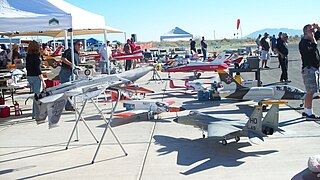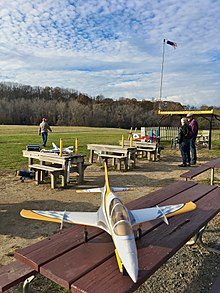
A model aircraft is a small unmanned aircraft. Many are replicas of real aircraft. Model aircraft are divided into two basic groups: flying and non-flying. Non-flying models are also termed static, display, or shelf models.

The Experimental Aircraft Association (EAA) is an international organization of aviation enthusiasts based in Oshkosh, Wisconsin, United States. Since its inception, it has grown internationally with over 200,000 members and nearly 1,000 chapters worldwide. It hosts the largest aviation gathering of its kind in the world, EAA AirVenture Oshkosh.

Free flight is the segment of model aviation involving aircraft with no active external control after launch. Free Flight is the original form of hobby aeromodeling, with the competitive objective being to build and launch a self controlling aircraft that will consistently achieve the longest flight duration over multiple competition rounds, within various class parameters.
The National Aeronautic Association of the United States (NAA) is a non-profit 501(c)(3) organization and a founding member of the Fédération Aéronautique Internationale (FAI). Founded in 1905, it is the oldest national aviation club in the United States and one of the oldest in the world, it serves as the “Aeroclub of the United States” and, by its Mission Statement it is "…dedicated to the advancement of the art, sport and science of aviation in the United States.” The NAA is headquartered at the Ronald Reagan Washington National Airport, in Washington, D.C.

A radio-controlled aircraft is a small flying machine that is radio controlled by an operator on the ground using a hand-held radio transmitter. The transmitter continuously communicates with a receiver within the craft that sends signals to servomechanisms (servos) which move the control surfaces based on the position of joysticks on the transmitter. The control surfaces, in turn, directly affect the orientation of the plane.

A radio-controlled helicopter is model aircraft which is distinct from a RC airplane because of the differences in construction, aerodynamics, and flight training. Several basic designs of RC helicopters exist, of which some are more maneuverable than others. The more maneuverable designs are often harder to fly, but benefit from greater aerobatic capabilities.

Park flyers are a class of small, primarily electric powered radio-controlled aircraft. The smallest class of park flyers are called micro planes and can be used in an enclosed area such as a gymnasium or a living room, while larger park flyers are used at park flyer sites. Models with low flying speed are more susceptible to wind and turbulence. Park flyers weigh no more than 2 pounds, allowing park flyers to have a speed limit of less than half of the current wind speed.

The Airports Authority of India (AAI) is a statutory body under the ownership of the Ministry of Civil Aviation, Government of India. It is responsible for creating, upgrading, maintaining, and managing civil aviation infrastructure in India. It provides Communication Navigation Surveillance/Air Traffic Management (CNS/ATM) services over the Indian airspace and adjoining oceanic areas. AAI currently manages a total of 137 airports, including 34 international airports, 10 Customs Airports, 81 domestic airports, and 23 Civil enclaves at Defence airfields. AAI also has ground installations at all airports and 25 other locations to ensure the safety of aircraft operations. AAI covers all major air routes over the Indian landmass via 29 Radar installations at 11 locations along with 700 VOR/DVOR installations co-located with Distance Measuring Equipment (DME). 52 runways are provided with Instrument landing system (ILS) installations with Night Landing Facilities at most of these airports and an Automatic Message Switching System at 15 Airports.

The Model Aeronautics Association of Canada (MAAC) is the official organization for all forms of the aeromodelling hobby, for model aircraft hobbyists living in Canada. Based in Burlington, Ontario, it was founded in 1949, and presently has over 13,000 members. MAAC is responsible for instituting official policies and regulations and guidelines. This includes radio frequencies, noise restrictions, and flying clubs. They organize flying events across Canada, and provide liability insurance coverage to its members.

International Miniature Aerobatic Club (IMAC) is a non-profit organization devoted to flying scale aerobatic model aircraft. IMAC is the main governing body responsible for hosting precision aerobatic contests with hundreds of pilots across the United States and Eastern Canada. The organization was founded in 1974 with 97 chartered members.

First-person view (FPV), also known as remote-person view (RPV), or video piloting, is a method used to control a radio-controlled vehicle from the driver or pilot's viewpoint. Most commonly it is used to pilot a radio-controlled aircraft or other type of unmanned aerial vehicle (UAV) such as a military drone. The operator gets a first-person perspective from an onboard camera that feeds video to FPV goggles or a monitor. More sophisticated setups include a pan-and-tilt gimbaled camera controlled by a gyroscope sensor in the pilot's goggles and with dual onboard cameras, enabling a true stereoscopic view.

The Wright Model B was an early pusher biplane designed by the Wright brothers in the United States in 1910. It was the first of their designs to be built in quantity. Unlike the Model A, it featured a true elevator carried at the tail rather than at the front. It was the last Wright model to have an open-frame tail. The Model B was a dedicated two-seater with the pilot and a passenger sitting side by side on the leading edge of the lower wing.

The Coachella Valley Radio Control Club is based near Coachella in Riverside County, California, United States. It is one of the oldest model aircraft clubs in the United States, one of the oldest non-profit service organizations in continuous existence in the Coachella Valley and one of the few Academy of Model Aeronautics gold-certified clubs in the country.
Model Aviation is the monthly full-color publication written, prepared and distributed by the Academy of Model Aeronautics beginning in 1936 and established as an independent publication in July 1975. The magazine is based in Muncie, Indiana.
Robert E. Thacker was an American test pilot, aeromodeling enthusiast and designer, one of the few pilots in history to do tours of duty in two different theaters of operation in World War II and the holder of a number of aviation records.

The Torrey Pines Gliderport is a city-owned private-use glider airport located in the La Jolla neighborhood of San Diego, California, United States, 11 nautical miles (20 km) northwest of the city's central business district.

Wings Across America 2008 (WAA-08) was a group of model airplane enthusiasts that flew a battery-powered radio-controlled aircraft (RC), designated as a park flyer, in all 48 contiguous United States with hopes to make all 50, if Alaska and Hawaii could be reached. A park flyer is a small radio-controlled plane typically flown in a field such as a local park or soccer field.

The Aeronautical Institute of Bangladesh or AIB is an aviation school in Bangladesh. AIB is the first private aeronautical institute in Bangladesh. The institute is under the Civil Aviation Authority of Bangladesh and governed by the Bangladesh Technical Education Board and Civil Aviation Authority of Bangladesh.

The Model Aeronautical Association of Australia Inc (MAAA) is an organisation recognised by CASA as a Recreational Aviation Administration Organisation. MAAA has no regulatory authority conferred to it by the CASA, however is required under a Deed of Agreement with CASA as an RAAO, to carry out certain functions on behalf of CASA paid from the public purse. It is affiliated to the Fédération Aéronautique Internationale through the Australian Sport Aviation Confederation. Founded in 1947, the MAAA presently has over 10,000 members down from a high of 12,000 in 2012 and total assets including flying fields, land and equipment worth more than $4 million AUD.
MultiGP is a global drone racing league that governs and manages radio-controlled drone racing competitions. With over 14,000 members and 544 chapters worldwide, MultiGP is the only drone racing league with clear and available methods for participation and advancement within the league. MultiGP governs and sanctions drone racing events across the world, provides turn-key race production services, and works with groups to grow the sport of drone racing.

















